Abstract
Urine testing for drug use in the workplace is now widespread, with the prevalence of positive drug tests in the work force being 0% to 15%. The prevalence of marijuana use is highest, and this can be reliably tested. Though it is prudent to rid the workplace of drug use, there is little scientific study on the relationship of drug use and workplace outcomes, such as productivity and safety. Probable-cause testing and preemployment testing are the most common applications. Random testing has been less accepted owing to its higher costs, unresolved legal issues, and predictably poor test reliability. Legal issues have focused on the right to policy, discrimination, and the lack of due process. The legal cornerstone of a good program is a policy that is planned and agreed on by both labor and management, which serves both as a contract and as a procedure in which expectations and consequences are known. The National Institute on Drug Abuse is certifying laboratories doing employee drug testing. Testing methods when done correctly are less prone to error than in the past, but screening tests can be defeated by adulterants. Although the incidence of false-positive results is low, such tests are less reliable when the prevalence of drug abuse is also low.
Full text
PDF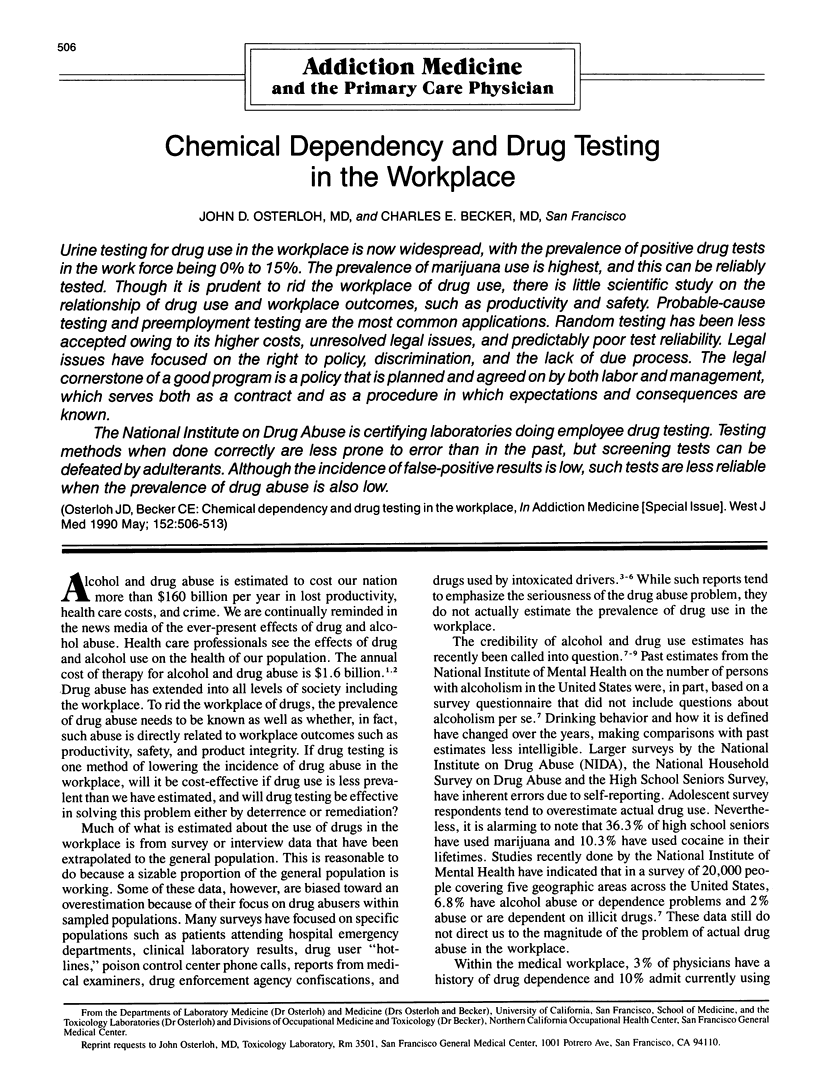
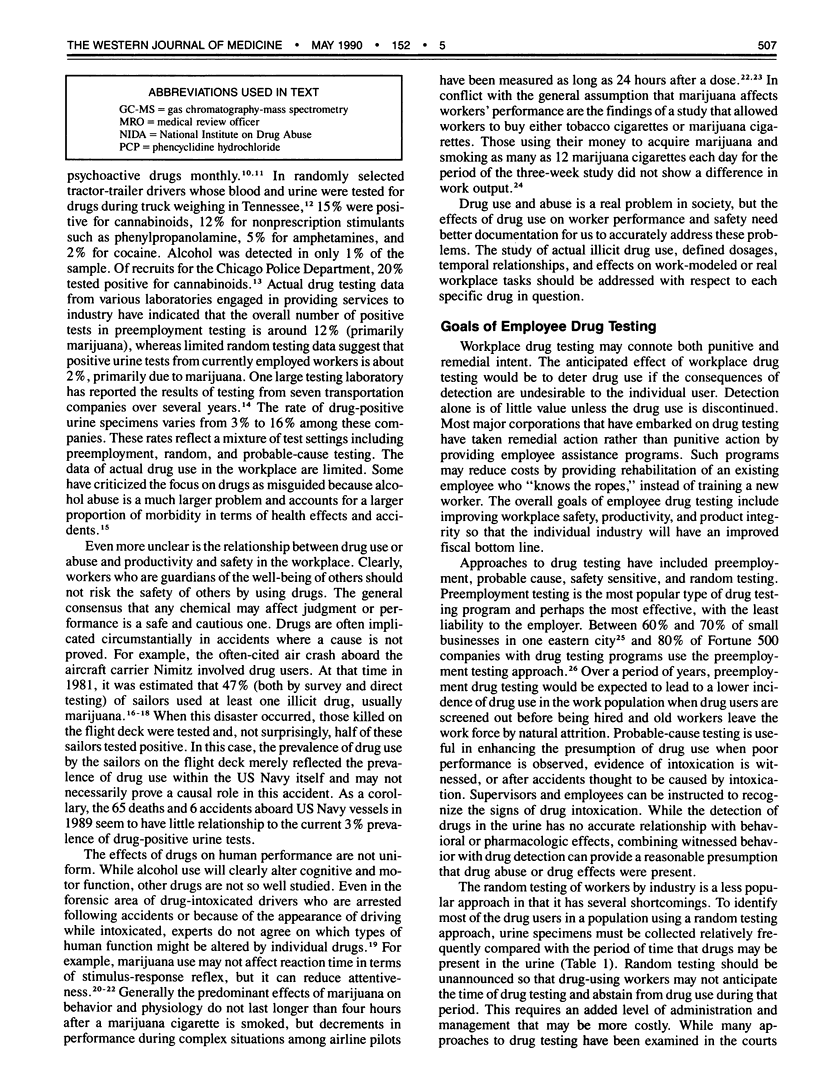
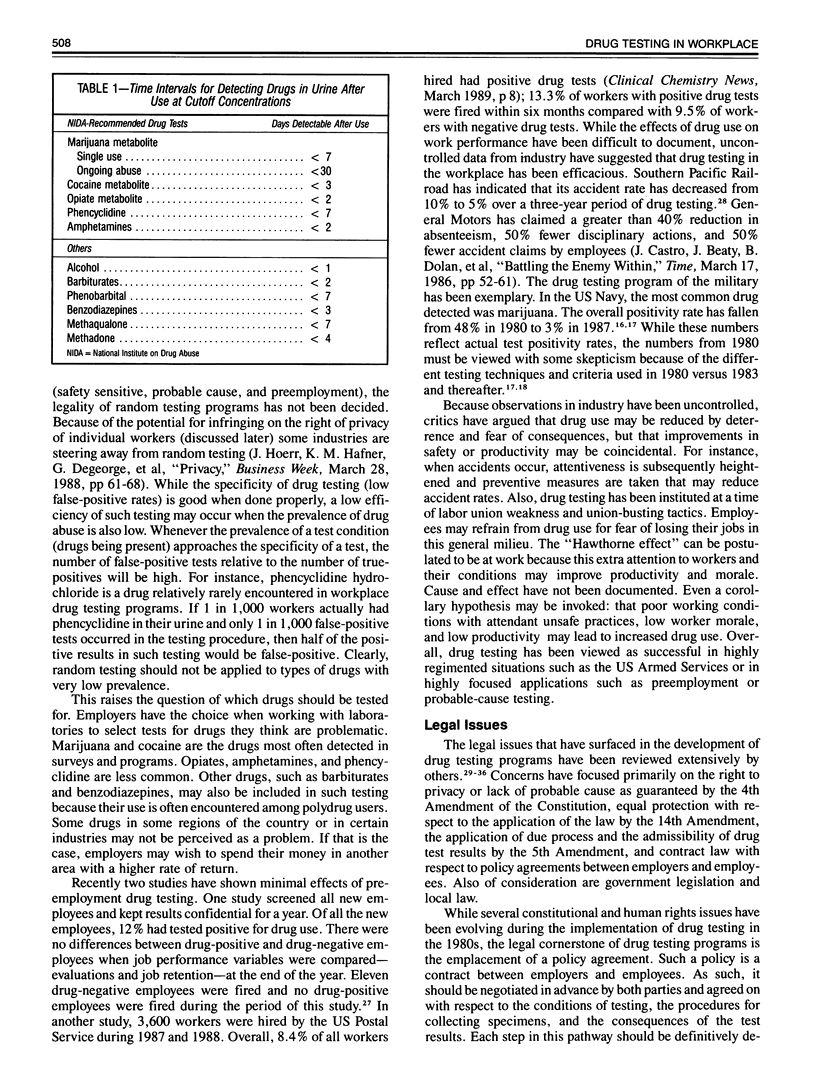
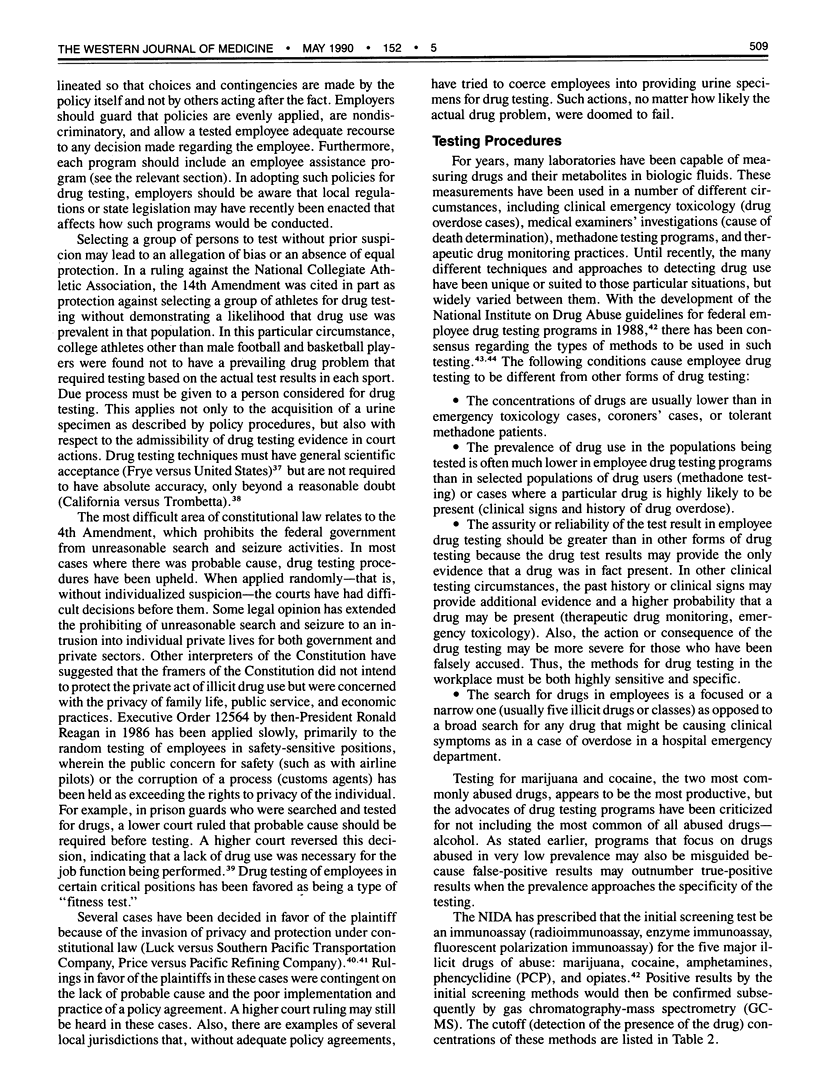
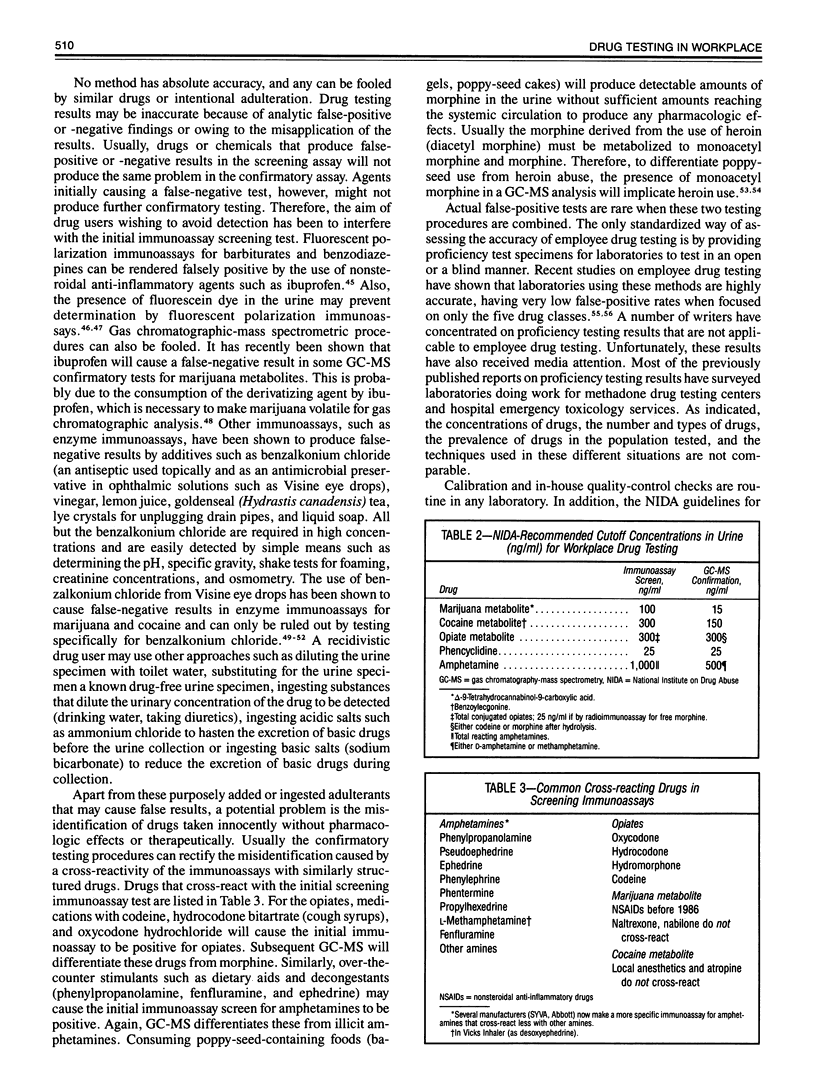
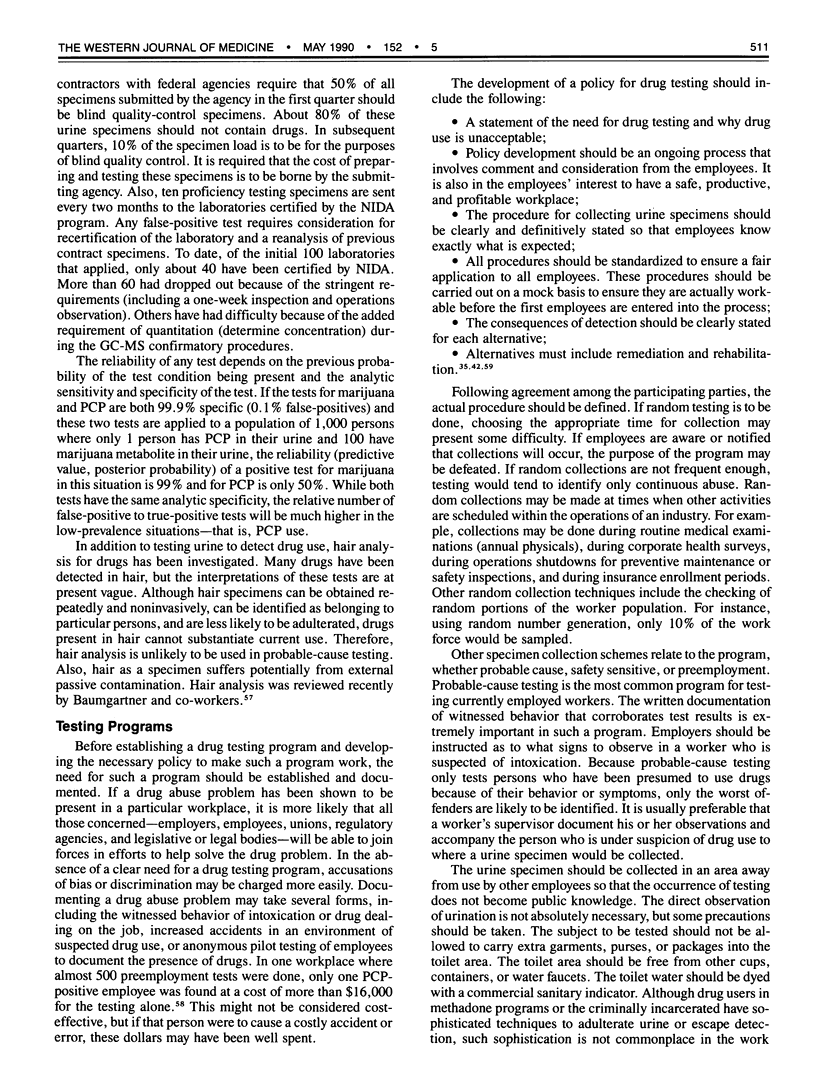
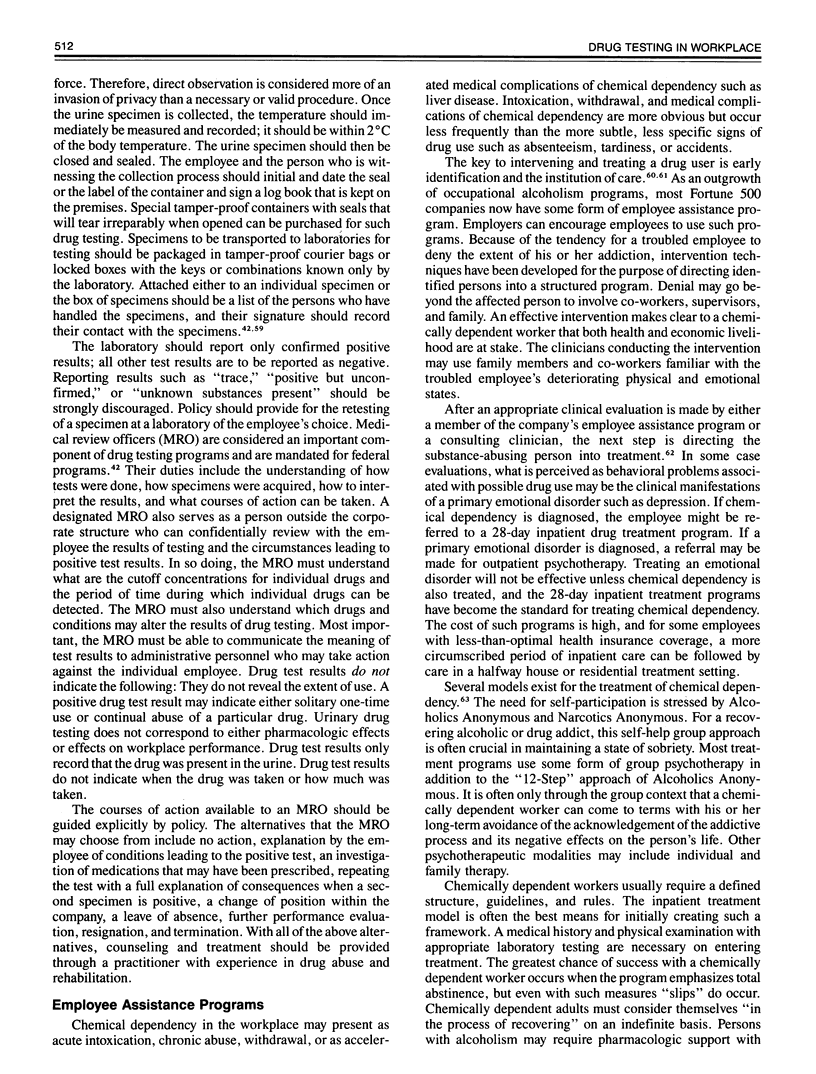
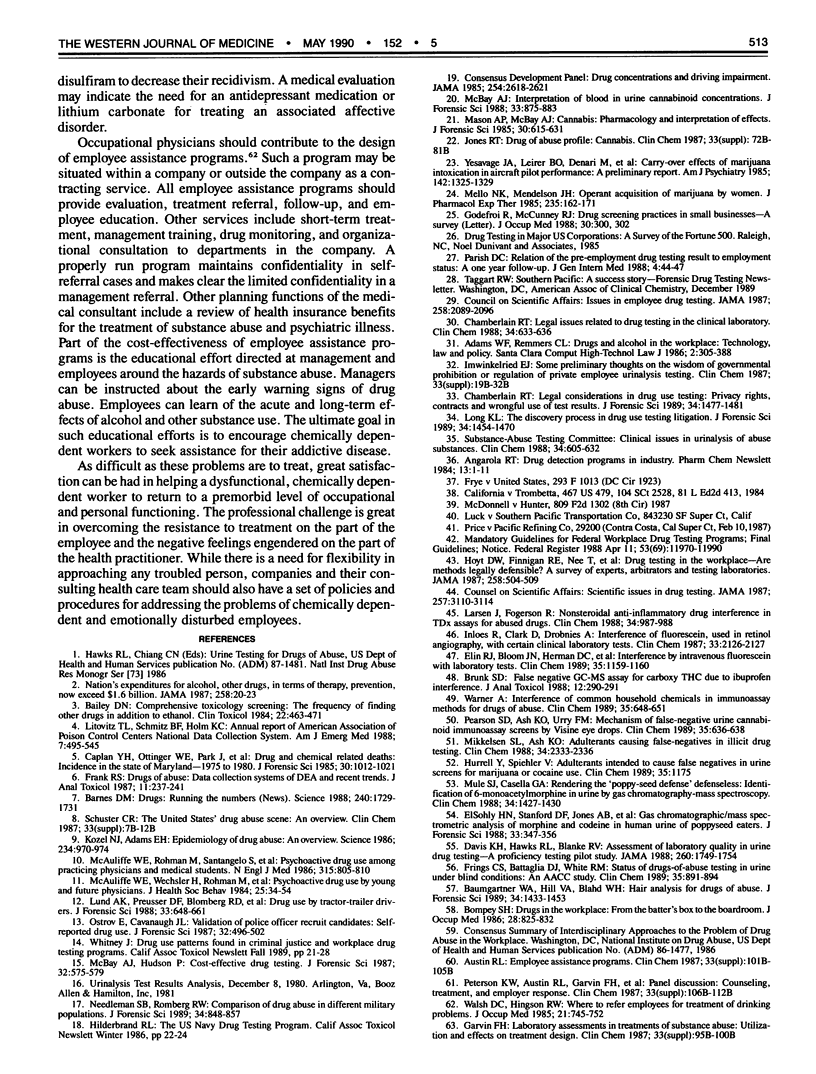
Selected References
These references are in PubMed. This may not be the complete list of references from this article.
- Austin R. L. Employee assistance programs. Clin Chem. 1987 Oct;33(11 Suppl):101B–105B. [PubMed] [Google Scholar]
- Bailey D. N. Comprehensive toxicology screening: the frequency of finding other drugs in addition to ethanol. J Toxicol Clin Toxicol. 1984;22(5):463–471. doi: 10.3109/15563658408992577. [DOI] [PubMed] [Google Scholar]
- Barnes D. M. Drugs: running the numbers. Science. 1988 Jun 24;240(4860):1729–1731. doi: 10.1126/science.3381095. [DOI] [PubMed] [Google Scholar]
- Bompey S. H. Drugs in the workplace: from the batter's box to the boardroom. J Occup Med. 1986 Sep;28(9):825–832. doi: 10.1097/00043764-198609000-00014. [DOI] [PubMed] [Google Scholar]
- Brunk S. D. False negative GC/MS assay for carboxy THC due to ibuprofen interference. J Anal Toxicol. 1988 Sep-Oct;12(5):290–291. doi: 10.1093/jat/12.5.290. [DOI] [PubMed] [Google Scholar]
- Caplan Y. H., Ottinger W. E., Park J., Smith T. D. Drug and chemical related deaths: incidence in the State of Maryland--1975 to 1980. J Forensic Sci. 1985 Oct;30(4):1012–1021. [PubMed] [Google Scholar]
- Chamberlain R. T. Legal issues related to drug testing in the clinical laboratory. Clin Chem. 1988 Mar;34(3):633–636. [PubMed] [Google Scholar]
- Davis K. H., Hawks R. L., Blanke R. V. Assessment of laboratory quality in urine drug testing. A proficiency testing pilot study. JAMA. 1988 Sep 23;260(12):1749–1754. [PubMed] [Google Scholar]
- Frank R. S. Drugs of abuse: data collection systems of DEA and recent trends. J Anal Toxicol. 1987 Nov-Dec;11(6):237–241. doi: 10.1093/jat/11.6.237. [DOI] [PubMed] [Google Scholar]
- Frings C. S., Battaglia D. J., White R. M. Status of drugs-of-abuse testing in urine under blind conditions: an AACC study. Clin Chem. 1989 May;35(5):891–894. [PubMed] [Google Scholar]
- Godefroi R., McCunney R. J. Drug screening practices in small businesses: a survey. J Occup Med. 1988 Apr;30(4):300–302. [PubMed] [Google Scholar]
- Hoyt D. W., Finnigan R. E., Nee T., Shults T. F., Butler T. J. Drug testing in the workplace--are methods legally defensible? A survey of experts, arbitrators, and testing laboratories. JAMA. 1987 Jul 24;258(4):504–509. doi: 10.1001/jama.1987.03400040102031. [DOI] [PubMed] [Google Scholar]
- Imwinkelried E. J. Some preliminary thoughts on the wisdom of governmental prohibition or regulation of private employee urinalysis testing. Clin Chem. 1987 Oct;33(11 Suppl):19B–32B. [PubMed] [Google Scholar]
- Inloes R., Clark D., Drobnies A. Interference of fluorescein, used in retinal angiography, with certain clinical laboratory tests. Clin Chem. 1987 Nov;33(11):2126–2127. [PubMed] [Google Scholar]
- Jones R. T. Drug of abuse profile: cannabis. Clin Chem. 1987 Oct;33(11 Suppl):72B–81B. [PubMed] [Google Scholar]
- Kozel N. J., Adams E. H. Epidemiology of drug abuse: an overview. Science. 1986 Nov 21;234(4779):970–974. doi: 10.1126/science.3490691. [DOI] [PubMed] [Google Scholar]
- Larsen J., Fogerson R. Nonsteroidal anti-inflammatory drug interference in TDx assays for abused drugs. Clin Chem. 1988 May;34(5):987–988. [PubMed] [Google Scholar]
- Litovitz T. L., Schmitz B. F., Holm K. C. 1988 annual report of the American Association of Poison Control Centers National Data Collection System. Am J Emerg Med. 1989 Sep;7(5):495–545. doi: 10.1016/0735-6757(89)90252-0. [DOI] [PubMed] [Google Scholar]
- Lund A. K., Preusser D. F., Blomberg R. D., Williams A. F. Drug use by tractor-trailer drivers. J Forensic Sci. 1988 May;33(3):648–661. [PubMed] [Google Scholar]
- Mason A. P., McBay A. J. Cannabis: pharmacology and interpretation of effects. J Forensic Sci. 1985 Jul;30(3):615–631. [PubMed] [Google Scholar]
- McAuliffe W. E., Rohman M., Santangelo S., Feldman B., Magnuson E., Sobol A., Weissman J. Psychoactive drug use among practicing physicians and medical students. N Engl J Med. 1986 Sep 25;315(13):805–810. doi: 10.1056/NEJM198609253151305. [DOI] [PubMed] [Google Scholar]
- McAuliffe W. E., Wechsler H., Rohman M., Soboroff S. H., Fishman P., Toth D., Friedman R. Psychoactive drug use by young and future physicians. J Health Soc Behav. 1984 Mar;25(1):34–54. [PubMed] [Google Scholar]
- McBay A. J., Hudson P. Cost-effective drug testing. J Forensic Sci. 1987 May;32(3):575–579. [PubMed] [Google Scholar]
- McBay A. J. Interpretation of blood and urine cannabinoid concentrations. J Forensic Sci. 1988 Jul;33(4):875–883. [PubMed] [Google Scholar]
- Mello N. K., Mendelson J. H. Operant acquisition of marihuana by women. J Pharmacol Exp Ther. 1985 Oct;235(1):162–171. [PubMed] [Google Scholar]
- Mikkelsen S. L., Ash K. O. Adulterants causing false negatives in illicit drug testing. Clin Chem. 1988 Nov;34(11):2333–2336. [PubMed] [Google Scholar]
- Mulé S. J., Casella G. A. Rendering the "poppy-seed defense" defenseless: identification of 6-monoacetylmorphine in urine by gas chromatography/mass spectroscopy. Clin Chem. 1988 Jul;34(7):1427–1430. [PubMed] [Google Scholar]
- Needleman S. B., Romberg R. W. Comparison of drug abuse in different military populations. J Forensic Sci. 1989 Jul;34(4):848–857. [PubMed] [Google Scholar]
- Ostrov E., Cavanaugh J. L., Jr Validation of police officer recruit candidates' self-reported drug use. J Forensic Sci. 1987 Mar;32(2):496–502. [PubMed] [Google Scholar]
- Parish D. C. Relation of the pre-employment drug testing result to employment status: a one-year follow-up. J Gen Intern Med. 1989 Jan-Feb;4(1):44–47. doi: 10.1007/BF02596490. [DOI] [PubMed] [Google Scholar]
- Pearson S. D., Ash K. O., Urry F. M. Mechanism of false-negative urine cannabinoid immunoassay screens by Visine eyedrops. Clin Chem. 1989 Apr;35(4):636–638. [PubMed] [Google Scholar]
- Schuster C. R. The United States' drug abuse scene: an overview. Clin Chem. 1987 Oct;33(11 Suppl):7B–12B. [PubMed] [Google Scholar]
- Walsh D. C., Hingson R. W. Where to refer employees for treatment of drinking problems. The limited lessons from empirical research. J Occup Med. 1985 Oct;27(10):745–752. [PubMed] [Google Scholar]
- Warner A. Interference of common household chemicals in immunoassay methods for drugs of abuse. Clin Chem. 1989 Apr;35(4):648–651. [PubMed] [Google Scholar]
- Yesavage J. A., Leirer V. O., Denari M., Hollister L. E. Carry-over effects of marijuana intoxication on aircraft pilot performance: a preliminary report. Am J Psychiatry. 1985 Nov;142(11):1325–1329. doi: 10.1176/ajp.142.11.1325. [DOI] [PubMed] [Google Scholar]
- elSohly H. N., Stanford D. F., Jones A. B., elSohly M. A., Snyder H., Pedersen C. Gas chromatographic/mass spectrometric analysis of morphine and codeine in human urine of poppy seed eaters. J Forensic Sci. 1988 Mar;33(2):347–356. [PubMed] [Google Scholar]


